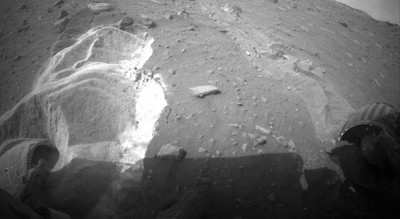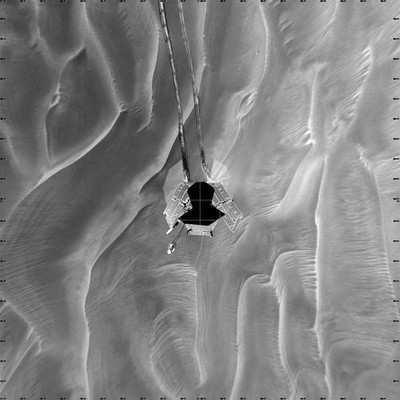Spirit Finds Evidence of Subsurface Water
The ground where NASA's Mars Exploration Rover Spirit became
stuck last year holds evidence that water, perhaps as snow melt,
trickled into the subsurface fairly recently and on a continuing
basis.

Spirit Rover NASA Image
Stratified soil layers with different compositions close to the
surface led the rover science team to propose that thin films of
water may have entered the ground from frost or snow. The seepage
could have happened during cyclical climate changes during periods
when Mars tilted farther on its axis. The water may have moved down
into the sand, carrying soluble minerals deeper than less-soluble
ones. Spin-axis tilt varies over timescales of hundreds of
thousands of years.
The relatively insoluble minerals near the surface include what
is thought to be hematite, silica and gypsum. Ferric sulfates,
which are more soluble, appear to have been dissolved and carried
down by water. None of these minerals is exposed at the surface,
which is covered by wind-blown sand and dust.
"The lack of exposures at the surface indicates the preferential
dissolution of ferric sulfates must be a relatively recent and
ongoing process since wind has been systematically stripping soil
and altering landscapes in the region Spirit has been examining,"
said Ray Arvidson of Washington University in St. Louis, deputy
principal investigator for the twin rovers Spirit and
Opportunity.

Water Evidence Discovered In 2004 NASA Image
Analysis of these findings appears in a report in the Journal of
Geophysical Research published by Arvidson and 36 co-authors about
Spirit's operations from late 2007 until just before the rover
stopped communicating in March.
The twin Mars rovers finished their three-month prime missions
in April 2004, then kept exploring in bonus missions. One of
Spirit's six wheels quit working in 2006.
In April 2009, Spirit's left wheels broke through a crust at a
site called "Troy" and churned into soft sand. A second wheel
stopped working seven months later. Spirit could not obtain a
position slanting its solar panels toward the sun for the winter,
as it had for previous winters. Engineers anticipated it would
enter a low-power, silent hibernation mode, and the rover stopped
communicating March 22. Spring begins next month at Spirit's site,
and NASA is using the Deep Space Network and the Mars Odyssey
orbiter to listen if the rover reawakens.
Researchers took advantage of Spirit's months at Troy last year
to examine in great detail soil layers the wheels had exposed, and
also neighboring surfaces. Spirit made 13 inches of progress in its
last 10 backward drives before energy levels fell too low for
further driving in February. Those drives exposed a new area of
soil for possible examination if Spirit does awaken and its robotic
arm is still usable.
"With insufficient solar energy during the winter, Spirit goes
into a deep-sleep hibernation mode where all rover systems are
turned off, including the radio and survival heaters," said John
Callas, project manager for Spirit and Opportunity at NASA's Jet
Propulsion Laboratory, in Pasadena, CA. "All available solar array
energy goes into charging the batteries and keeping the mission
clock running."

Opportunity Rover NASA Image
The rover is expected to have experienced temperatures colder
than it has ever before, and it may not survive. If Spirit does get
back to work, the top priority is a multi-month study that can be
done without driving the rover. The study would measure the
rotation of Mars through the Doppler signature of the stationary
rover's radio signal with enough precision to gain new information
about the planet's core. The rover Opportunity has been making
steady progress toward a large crater, Endeavour, which is now
approximately 5 miles away.
Spirit, Opportunity, and other NASA Mars missions have found
evidence of wet Martian environments billions of years ago that
were possibly favorable for life. The Phoenix Mars Lander in 2008
and observations by orbiters since 2002 have identified buried
layers of water ice at high and middle latitudes and frozen water
in polar ice caps. These newest Spirit findings contribute to an
accumulating set of clues that Mars may still have small amounts of
liquid water at some periods during ongoing climate cycles.
NASA's Jet Propulsion Laboratory manages the rovers for the
agency's Science Mission Directorate in Washington.
 Aero-News: Quote of the Day (04.28.25)
Aero-News: Quote of the Day (04.28.25) ANN's Daily Aero-Term (04.28.25): Decision Altitude (DA)
ANN's Daily Aero-Term (04.28.25): Decision Altitude (DA) ANN's Daily Aero-Linx (04.28.25)
ANN's Daily Aero-Linx (04.28.25) Airborne-Flight Training 04.24.25: GA Refocused, Seminole/Epic, WestJet v TFWP
Airborne-Flight Training 04.24.25: GA Refocused, Seminole/Epic, WestJet v TFWP Aero-News: Quote of the Day (04.29.25)
Aero-News: Quote of the Day (04.29.25)





